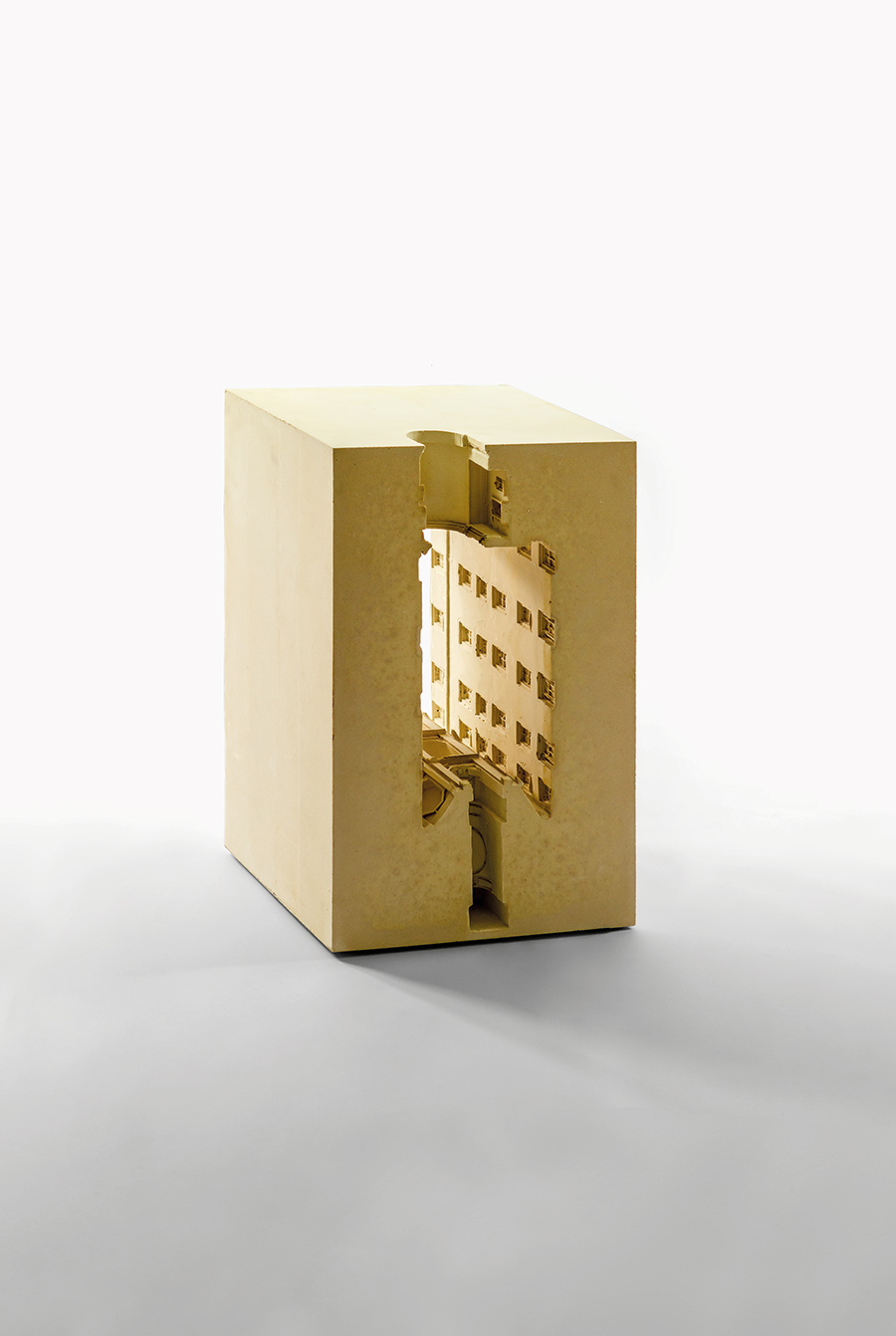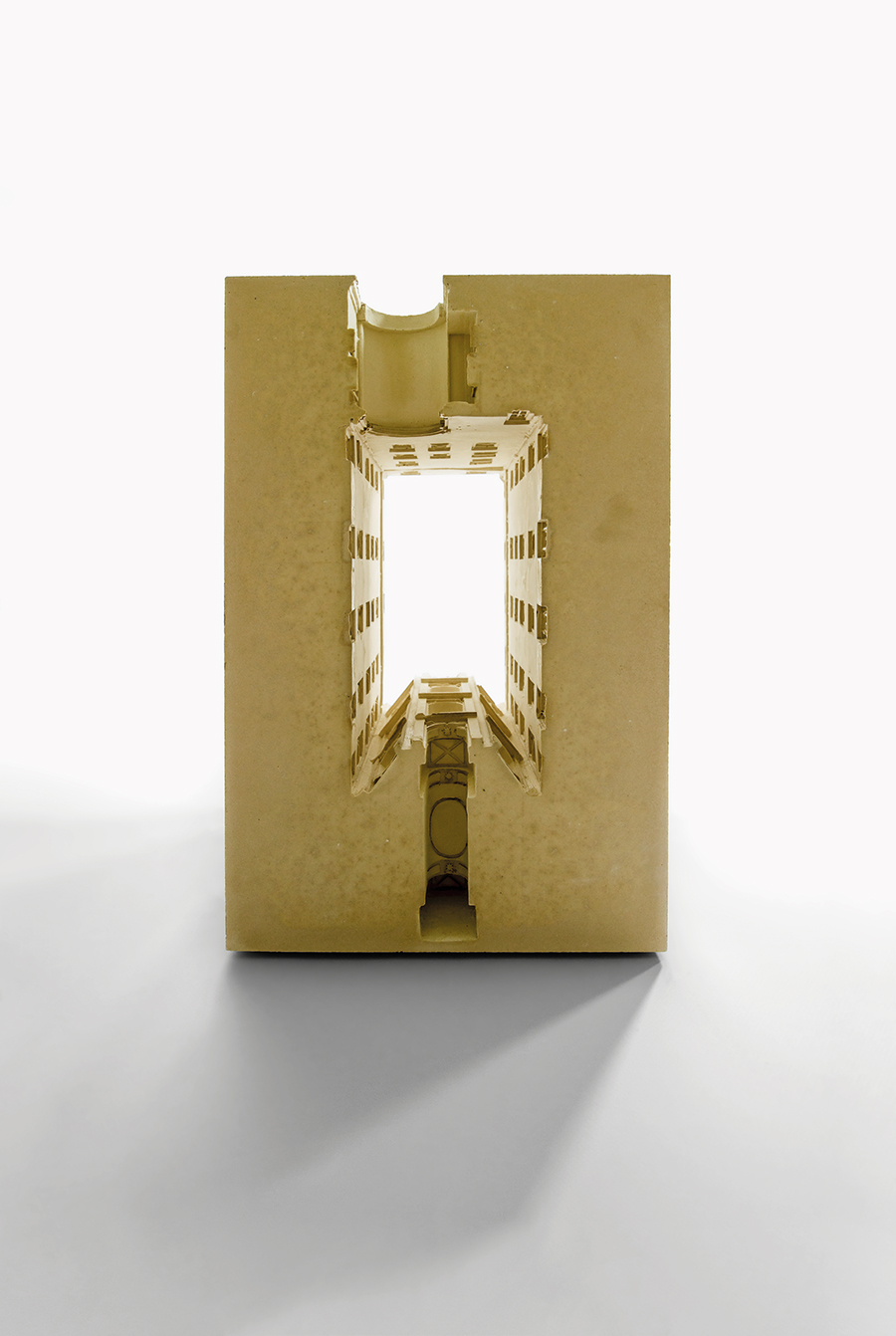

For the main staircase of his own palazzo Ferdinando Sanfelice had chosen, from all conceivable staircase types, the one that required most space: an axially symmetric arrangement that is in fact two stairs of four flights each. They turn in opposite directions to each other and come together for the last central flight of the four; after which this sequence is repeated through all floors. However, the architect also showed great skill in inventing forms of staircases suitable to more cramped sites or existing courtyards. He had great dexterity in producing designs adapted to a client’s degree of financial means and crave for monumentality. More than anything else it is this capacity that makes Sanfelice the foremost protagonist of staircase design in Naples.
His involvement in the construction of new palaces in the Sanità and Vergini quarters aside—such as his own and the nearly contemporaneous palazzo Di Majo (1726)—Ferdinando was also intervening in the denser city centre, in existing structures dating mostly from the fifteenth and early sixteenth century, for various clients.¹ As already mentioned, in a few cases his clients were both immediate and distant relatives. This was the case with Palazzo Lauriano, built for Ferdinando’s nephew, Gennaro delli Monti Sanfelice, Duca di Lauriano, in via San Paolo, formerly vico San Pellegrino a San Paolo. This palazzo, now occupied by the Suore del Preziosissimo Sangue, has due to a misintrepretation often been referred to as Palazzo Capuano.² Nevertheless, the Neapolitan biographer Bernardo De Dominici is clear: in his Vite de’ pittori, scultori, ed architetti napoletani, he describes the duke’s commission as “near the Seggio di Montagna” (where the Sanfelice’s were actively involved) and says that Sanfelice added to it a staircase planned as an octagon to avoid blocking the windows in the adjacent wings.³ This is exactly what Sanfelice was doing, likely around 1730, when remodelling the old structure, of which a fifteenth-century arch remains at the interior side of the vestibule. The architect also added a new portal, but the main feature is indeed his extraordinary solution for the staircase, at the end of the deep cortile. It stands as an autonomous architecture, as much a tower as it is a staircase. It has a stretched octagonal base that, De Dominici explains, has a practical reason: “a double staircase of such a beautiful invention, octagonally made on its outside as to not impede the light from entering the lateral windows of the rooms”, and he further praises the stairs’ practical lay-out and convenience.⁴ Inventive in its geometrical structure, this imposing, dramatic and theatrical staircase is entirely functional in its distribution to the various apartments. As is the case in contemporary tall buildings on closely packed Neapolitan sites, several apartments of basically equal status were stacked one on top of the other. Often it was not the first but the second floor that was regarded as the actual piano nobile: owing to the narrowness of the streets, it offered better light conditions. Such buildings, originating in the custom of living together in the ramifications of family clans, were now being built as leased property with flats that could be rented individually.
Due to the staircase design, with its robust central pillars, the entrances to the apartments are provided with a relative privacy. Both symmetrical ramps of the Lauriano staircase run round these solid triangular newels, while the outer walls open to light shafts at the back, and to the courtyard at the front. The openings have ingenious surrounds, oblique with respect to the wall in which they stand, so that they appear symmetrical as one approaches up the court or comes down the staircase. It is only one of the instances of how Sanfelice masters, more than any of his colleagues, the effects of diagonal stairs in façade design—often considered pernicious—and succeeds in turning them into a trump.
Compared to staircase designs by his fellow Neapolitan architects, Sanfelice’s structure at palazzo Lauriano shows muscle and vigour and is, as was already the case in his own palace, devoid of the figurative trimmings that were often crucial to stairs built in these and the following years by his contemporaries. Contrary to his rivals, such as Antonio Vaccaro, whose architectural language is often dissolved into decorative elements, Sanfelice was above all interested in the creation of spatial form, frequently by the use of highly ingenious plans, plain structural means, and elementary yet unexpected detailing.
1. It is documented that he was active in the centre for various clients, at least in the early 1740s: cf. Maria Gabriella Pezone, Geometria e arditezza tecnica nelle scale napoletane del Settecento a matrice poligonale, in: Giosi Amirante and M. Gabriella Pezone, eds., Tra Napoli e Spagna: Città storica, architetti e architetture tra XVI e XVIII secolo. Napoli, Grimaldi, 2015; pp. 123-148; here p. 130-132.
2. In his appendix B to his volume on Neapolitan Baroque architecture, The identification of Sanfelice’s buildings, Blunt argued that “there is unfortunately much confusion about two important palaces by Sanfelice, one built for his nephew, the Duca di Lauriano, the other for his brother-in-law, Carlo Capuano, Marchese della Petina.” See for more detail Blunt 1975: 192. Concerning the misinterpretation see also: Alastair M. Ward, The Architecture of Ferdinando Sanfelice. New York/London, Garland, 1988; pp. 257-260, especially 259. And the discussion in Pezone 2015: 147, n. 49.
3. Bernardo De Dominici, Vite de’ pittori, scultori, ed architetti napoletani, 3 vols. Napoli, Stamperia del Ricciardi, 1742-45; III, p. 657.
4. De Dominici 1742-45: III, 657.